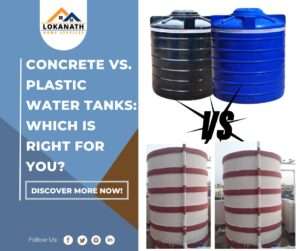Concrete vs. Plastic Water Tanks: Which is Right for You?

Welcome to Lokanath Home Services' in-depth guide on selecting the ideal overhead water tank for your needs. In this comprehensive blog post, we'll explore the nuances between concrete and plastic water tanks, providing valuable insights to assist you in making a well-informed decision.
Understanding the Materials
Concrete Water Tanks:
Concrete water tanks are renowned for their durability and strength. Constructed on-site using reinforced concrete, these tanks offer exceptional longevity, making them a popular choice for many homeowners and businesses. However, they require careful maintenance to prevent cracks and leaks over time.
Plastic Water Tanks:
Plastic water tanks, crafted from high-density polyethylene or polypropylene materials, offer a lightweight alternative to concrete tanks. Despite their lighter weight, these tanks are incredibly durable and resistant to corrosion. They require minimal maintenance and are easy to install, making them a convenient choice for various applications.
Factors to Consider When Choosing
Capacity:
Consider your water storage needs and choose a tank with the appropriate capacity to accommodate your household or business requirements.
Space Constraints:
Evaluate the available space for tank installation, as concrete tanks typically require more space compared to their plastic counterparts.
Budget:
Assess the initial cost, installation expenses, and long-term maintenance costs associated with each tank type to determine the most cost-effective option for your budget.
Durability:
Examine the durability and expected lifespan of concrete and plastic water tanks, considering factors such as climate, seismic activity, and water quality.
Environmental Impact:
Compare the environmental footprint of manufacturing, transportation, and disposal of concrete and plastic tanks to make an environmentally conscious decision.
Pros and Cons
Concrete Water Tanks:
- Pros: Longevity, strength, suitable for underground installation, minimal risk of UV degradation.
- Cons: Higher initial cost, heavy weight requiring sturdy foundation, the potential for cracks and leaks over time.
Plastic Water Tanks:
- Pros: Lightweight, easy to install, resistant to corrosion and rust, lower initial cost, recyclable. Learn more about the benefits of plastic water tanks from industry-leading manufacturers like Sintex, Supreme, Plasto, Prince, and more.
- Cons: Vulnerable to UV degradation if not UV-stabilized, shorter lifespan compared to concrete tanks.
The blog summarizes key points and stresses the importance of selecting the right overhead water tank based on individual needs. Consider the pros and cons carefully. For more information on water tank installation and maintenance services, visit Lokanath Home Services.

